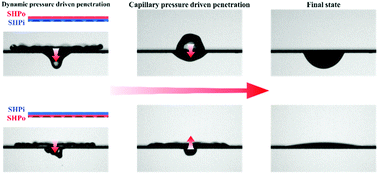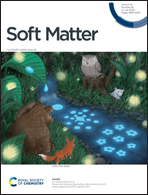Water penetration dynamics through a Janus mesh during drop impact†
Abstract
Here, we study the water penetration dynamics through a Janus membrane with opposite wettability, i.e., (super-) hydrophobic on one side and (super-) hydrophilic on the other side, during drop impact. It is demonstrated that the penetration dynamics through the membrane consists of two temporally distinct events: dynamic pressure driven penetration dynamics on a shorter timescale and capillary pressure driven penetration dynamics on a longer timescale. For penetration under dynamic pressure, the threshold velocity for the penetration is dependent on the wettability of the impact side, such that a smaller impact velocity is required for water penetration when a water drop is impinged onto the superhydrophobic side over the superhydrophilic side. We demonstrate that this difference in the penetration dynamics upon drop impact can still be accounted for by the balance between the dynamic pressure and the capillarity pressure after adjusting the relative magnitude of the two contrasting pressures required for the penetration. Meanwhile, it is demonstrated that the penetration dynamics under capillary pressure is governed by the balance between the capillary pressure and the viscous pressure while the penetration mainly proceeds through the penetration area, which is formed during short-time penetration, showing the dynamic coupling between the two penetration dynamics. By elucidating the penetration dynamics on a Janus membrane, we believe that our results can help in designing Janus membranes for various fluidic applications such as oil–water separation, aeration, and water harvesting.



 Please wait while we load your content...
Please wait while we load your content...